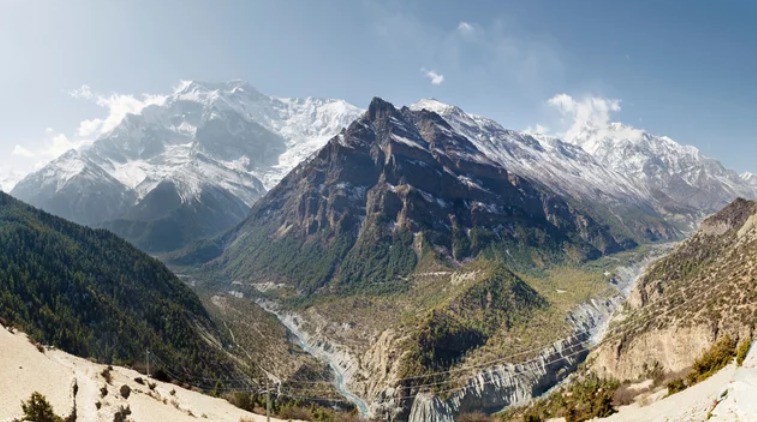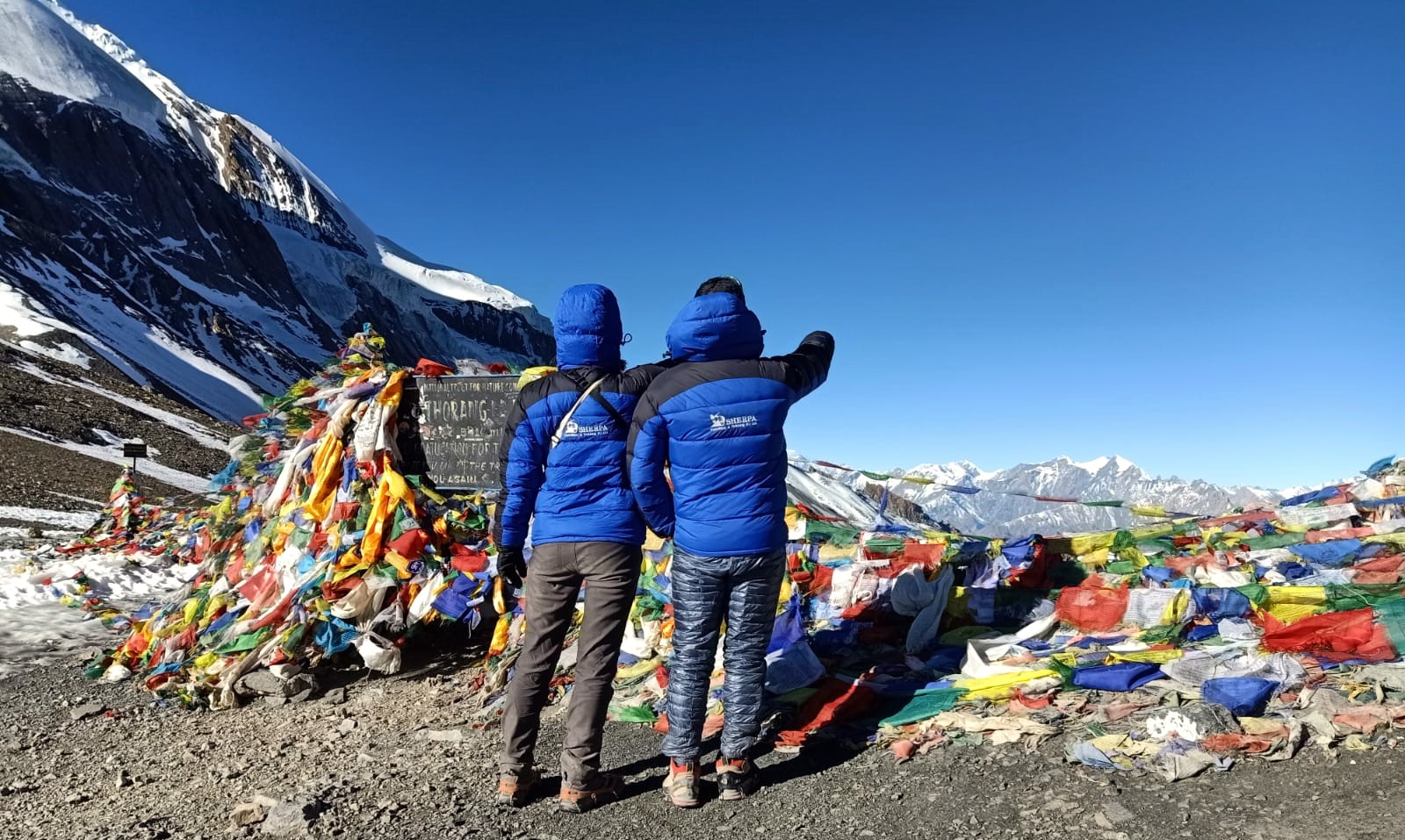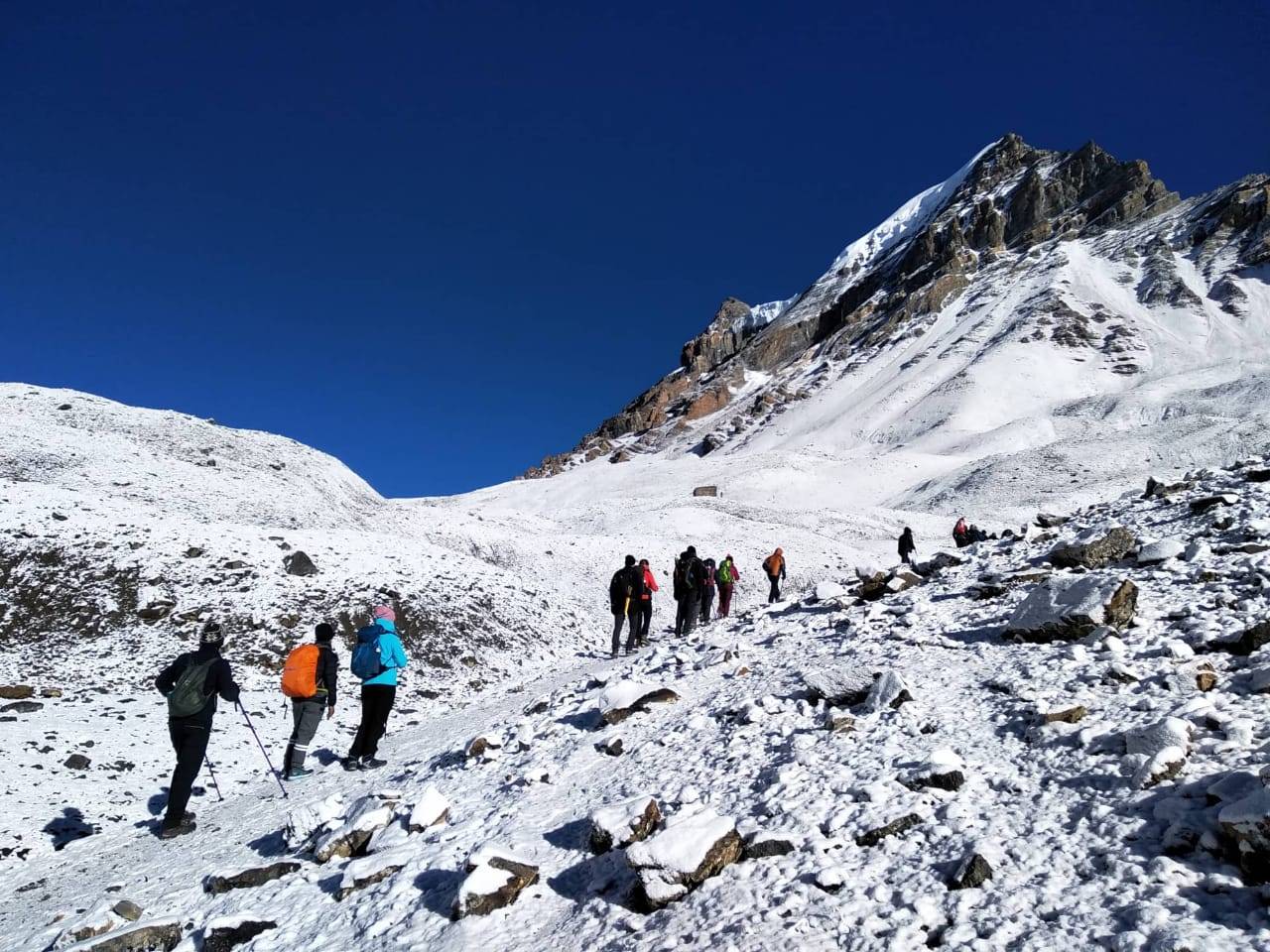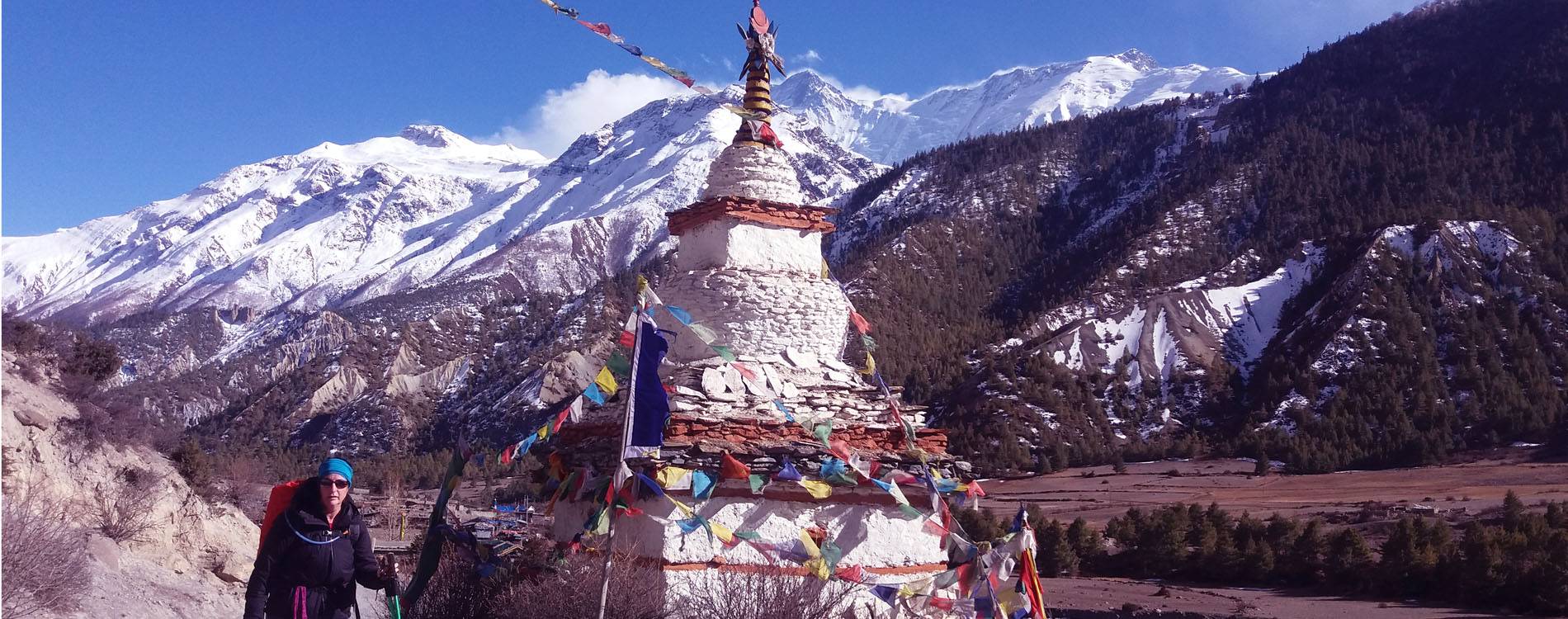26th August, 2025

Oct 31, 2023
Annapurna Circuit Trek In June
- Why Annapurna Circuit Trek In June
- How Hard Is Annapurna Circuit in June
- Highlights Of Annapurna Circuit Trek In June
- Advantages Of Annapurna Circuit Trek
- What Should I Pack for Annapurna Circuit Trek
- Permit, Guide, and Porter for Annapurna Circuit Trek
- Food, Accommodation, and Transportation on Annapurna Circuit Trek
- Successful Annapurna Circuit Trek Tips
- Can I Do It Solo? Annapurna Circuit Trek
- Solo Annapurna Circuit Trek
- Can I Do Annapurna Circuit Trek Without a Guide
- Conclusion
- Annapurna Circuit Packages
Trekking the Annapurna Circuit in June presents both challenges and unique rewards for adventurous travelers. As Nepal's monsoon season begins in June, the weather can be unpredictable, with frequent rainfall and cloudy skies. Despite these conditions, June offers stunning lush landscapes, vibrant greenery, and fewer crowds compared to peak seasons.
June marks the beginning of the monsoon, bringing rain showers that can affect trail conditions. Trekking paths may be muddy and slippery, requiring caution and proper footwear. It's essential to pack waterproof gear, including rain jackets, pants, and sturdy hiking boots, to stay dry and comfortable during daily hikes.
While the weather can be unpredictable, trekking in June offers breathtaking views of cascading waterfalls, blooming rhododendron forests, and terraced fields in full bloom. The lower elevation parts of the Annapurna Circuit, such as the Marsyangdi Valley and Manang region, are particularly lush and picturesque during this time.

ANNAPURNA CIRCUIT WITH TILICHO LAKE TREK 15 DAYS
This 15-day trek takes you through the Annapurna Conservation Area and to the highest alpine pass in the world – Thorong La Pass (5,416m/17,769ft) and to Tilicho Lake. You will also trek through the d...
Trekkers should be prepared for occasional flight delays or cancellations to and from the starting point at Pokhara due to weather conditions. It's advisable to have a flexible itinerary and allow extra days for unexpected delays.
Accommodation along the Annapurna Circuit is generally available in tea houses and lodges, providing warm hospitality and hearty meals despite the rainy weather. Local communities warmly welcome trekkers and offer insight into their unique cultures and traditions.
In conclusion, while trekking the Annapurna Circuit in June requires preparation for monsoon conditions, the lush landscapes, cultural experiences, and reduced crowds make it a rewarding adventure for those seeking a quieter trekking experience amidst Nepal's natural beauty. With proper gear and a flexible mindset, June can offer a memorable journey through one of the world's most spectacular trekking destinations.

ANNAPURNA CIRCUIT WITH TILICHO LAKE TREK 14 DAYS
This trek Opened for tourists in 1980, the Annapurna region has been recognized as one of the world's popular trekking destination destinations according to a recent survey by the American magazine Mo...
Why Annapurna Circuit Trek In June
Trekking the Annapurna Circuit in June offers a distinctive experience amidst Nepal's monsoon season. While this time of year typically brings occasional rain showers, it also blankets the landscape in lush greenery, transforming the region into a verdant paradise. The valleys are alive with blooming rhododendrons and cascading waterfalls, painting a picturesque backdrop against the towering Himalayan peaks. The reduced number of trekkers in June allows for a quieter journey, where one can immerse deeply in the serene beauty of nature and connect more intimately with the local culture along the trail. Despite the unpredictable weather, the unique charm of June lies in its ability to unveil the Annapurna region in its most vibrant form, making it a compelling choice for adventurous souls seeking both challenge and natural splendor.

ANNAPURNA CIRCUIT WITH TILICHO LAKE TREK 9 DAYS
Short 9 Days Annapurna Circuit Trek with Tilicho Lake is one of the most impressive and challenging hikes in Nepal. It’s an incredibly popular trekking destination in Nepal and around the world given...
How Hard Is Annapurna Circuit in June
Trekking the Annapurna Circuit in June presents both challenges and rewards. The main difficulty stems from the monsoon rains, which can make trails muddy and slippery, requiring cautious navigation. The weather can also be unpredictable, with occasional downpours that may impact visibility and trail conditions. However, with proper preparation including waterproof gear, a flexible itinerary, and a good level of fitness, the trek remains feasible. The route involves steep ascents and descents, particularly when crossing high mountain passes like Thorong La, demanding physical endurance and mental resilience. Despite the challenges, June offers its own allure with lush landscapes, clearer mountain views after rain showers, and a quieter trail experience. For trekkers prepared to embrace the unpredictable nature of the monsoon season, the Annapurna Circuit in June promises a memorable adventure amidst breathtaking Himalayan scenery.
Highlights Of Annapurna Circuit Trek In June
June transforms the Annapurna Circuit into a vibrant tapestry of natural beauty. One of the highlights is the lush greenery that blankets the valleys and hillsides, courtesy of the monsoon rains. The trails come alive with blooming rhododendrons, creating a colorful contrast against the backdrop of snow-capped peaks. Waterfalls cascade down the mountainsides, their roar echoing through the valleys, adding to the dramatic scenery. Trekking in June also offers clearer mountain views after rain showers, providing trekkers with stunning panoramas of the Himalayas. Cultural encounters with local communities along the route enrich the experience, offering insights into traditional mountain life amidst the challenging terrain. The quieter trails in June allow for a more peaceful and contemplative journey, where trekkers can fully immerse themselves in the natural splendor of the Annapurna region.

ANNAPURNA ROUND TREK
WORLD-CLASS TREK THROUGH THE (7,629 sq km) Annapurna Conservation Area – the largest in Nepal.The Annapurna Circuit has often been voted as the best long-distance trek in the world!This is a comprehen...
Advantages Of Annapurna Circuit Trek
The Annapurna Circuit trek presents several advantages that appeal to both seasoned trekkers and adventurers seeking a unique Himalayan experience. One significant advantage is the diversity of landscapes encountered along the route, from lush forests and cascading waterfalls to high mountain passes and barren valleys. This diversity ensures that every day of the trek offers new and awe-inspiring vistas, keeping the journey engaging and rewarding. Another advantage is the opportunity to witness Nepal's rich cultural heritage firsthand, with encounters with local communities and visits to traditional villages enriching the trekking experience.
Furthermore, the Annapurna Circuit is well-established with a network of teahouses and lodges, providing comfortable accommodations and hearty meals throughout the journey. This infrastructure ensures convenience and safety for trekkers, allowing them to focus on enjoying the trek and connecting with the natural and cultural wonders of the region. Overall, the Annapurna Circuit trek combines adventure with accessibility, making it a popular choice for those seeking a memorable Himalayan expedition.
What Should I Pack for Annapurna Circuit Trek
Packing wisely for the Annapurna Circuit trek ensures comfort, safety, and enjoyment amidst the varied terrain and unpredictable weather of the Himalayas. Essential items include sturdy, broken-in hiking boots with good ankle support for navigating rocky and uneven trails. Layered clothing is crucial to manage temperature changes: lightweight, moisture-wicking base layers, insulating mid-layers, and a waterproof and windproof outer shell are recommended. Pack enough socks and underwear for the duration of the trek, as well as a warm hat and gloves for chilly mornings and high-altitude evenings.
Other essentials include a durable backpack with a rain cover, a comfortable sleeping bag suitable for low temperatures, and a sleeping pad for insulation and comfort in teahouse accommodations. Toiletries like biodegradable soap, sunscreen, and a basic first aid kit with essentials like blister treatment, pain relievers, and altitude sickness medication are essential.
Bring a refillable water bottle and water purification tablets or a filtration system to stay hydrated from local water sources. A headlamp or flashlight with extra batteries is essential for navigating dark teahouses and early morning hikes. Lastly, carry essential documents such as a passport, permits, and travel insurance information in a waterproof pouch.
By packing thoughtfully and preparing for variable weather conditions and high-altitude challenges, you can ensure a safe and enjoyable Annapurna Circuit trekking experience.

ANNAPURNA CIRCUIT TREK
A LIFE-CHANGING EXPERIENCE – incredible beauty!Circumnavigate the Annapurnas – with one peak at 8091m & 28 peaks over 6000m surrounded by the Kali Gandaki Gorge, Marshyangdi River & Pokhara in...
Permit, Guide, and Porter for Annapurna Circuit Trek
Permits are essential for the Annapurna Circuit trek and can be obtained in Kathmandu or Pokhara. The required permits include the Annapurna Conservation Area Permit (ACAP) and the Trekkers' Information Management System (TIMS) card. These permits help support conservation efforts and ensure your safety by providing emergency information.
While not mandatory, hiring a local guide or porter is highly recommended, especially for those unfamiliar with the region. Guides offer valuable insight into local culture, flora, and fauna, while porters lighten your load, allowing you to focus on enjoying the trek. They also contribute to the local economy, benefiting communities along the route.
Food, Accommodation, and Transportation on Annapurna Circuit Trek
Teahouses line the Annapurna Circuit, offering basic lodging and meals such as dal bhat (rice and lentils), noodles, and tea. Accommodations vary from basic dormitories to private rooms with shared bathrooms, depending on your budget and preference. It's advisable to carry snacks and water purification tablets for added convenience.
Transportation to the starting point of the trek, typically Besisahar or Chame, can be arranged via bus or jeep from Kathmandu or Pokhara. Return transportation from the endpoint, usually Jomsom or Nayapul, is similarly available. Public buses are economical but can be crowded and less reliable during monsoon season.

15 DAYS ANNAPURNA CIRCUIT TREK
A WILD ADVENTURE AMONG SOARING PEAKS - THE DEEPEST VALLEY ON EARTH & EXPOSURE TO UNIQUE CULTURES.THIS TREK HAS IT ALL!The 15 Days Annapurna Circuit Trek is time well spent and will leave you with...
Successful Annapurna Circuit Trek Tips
Prepare physically by building stamina through regular cardio and strength training. Start slow to acclimatize to the altitude, taking rest days as needed. Stay hydrated and eat well to maintain energy levels. Pack light but include essentials like layers, rain gear, and sturdy footwear. Check weather forecasts and be flexible with your itinerary to avoid adverse conditions.
Can I Do It Solo? Annapurna Circuit Trek
Solo trekking on the Annapurna Circuit is feasible but comes with considerations. The route is well-marked, and teahouses provide accommodations, reducing the need for camping gear. However, the terrain and altitude require physical fitness and acclimatization awareness. Solo trekkers should obtain permits, carry a detailed map, and inform others of their itinerary. Hiring a guide or porter enhances safety and cultural immersion.

14 DAYS ANNAPURNA CIRCUIT TREK
RECOMMENDED WORLDWIDE! VISIT THE HIGHEST PASS & DEEPEST GORGE. An opportunity of a lifetime and adventure seeker’s paradise!The Annapurna Circuit Trek in 14 days with a drive to Chame and Muk...
Solo Annapurna Circuit Trek
Solo trekking the Annapurna Circuit offers freedom and solitude amidst stunning Himalayan landscapes. The route's popularity ensures you'll meet fellow trekkers along the way, enhancing camaraderie. Embrace the challenge and reward of navigating the diverse terrain independently while respecting local customs and environmental conservation efforts.
Can I Do Annapurna Circuit Trek Without a Guide
Yes, it is possible to trek the Annapurna Circuit without a guide, but it requires careful planning and preparation. The route is well-established with clear signage and teahouses along the way, making it feasible for independent trekkers. Basic knowledge of navigation and familiarity with trekking in remote areas are beneficial. Solo trekkers should obtain the necessary permits (Annapurna Conservation Area Permit and TIMS card) in advance and carry a detailed map or GPS device.
However, trekking without a guide means you are solely responsible for navigation, safety, and decision-making. It's essential to assess your physical fitness and acclimatization readiness for high-altitude trekking. Weather conditions can be unpredictable, especially during monsoon season, so flexibility in your itinerary is crucial.
While solo trekking offers freedom and solitude, consider the advantages of hiring a guide or joining a trekking group for added safety, cultural insights, and peace of mind. Guides provide local knowledge, emergency assistance, and enriching experiences through cultural exchanges with local communities. Ultimately, whether you choose to trek solo or with a guide, prioritize safety, respect local customs, and leave no trace to preserve the natural beauty of the Annapurna region.

12 DAYS ANNAPURNA CIRCUIT TREK
This classic 12 Days Annapurna Circuit Trek is one of the most popular treks in Nepal. Every year thousands embark on this adventure and return with memories to last a lifetime! On this trek you...
Conclusion
Trekking the Annapurna Circuit is a rewarding adventure whether you choose to go with a guide or independently. Each option offers unique experiences and challenges. For solo trekkers, thorough preparation, including obtaining permits, packing essentials, and assessing physical readiness, is essential. Hiring a guide enhances safety and enriches the journey with local insights and cultural interactions. Ultimately, the Annapurna Circuit welcomes all adventurers with its stunning landscapes, diverse cultures, and challenging terrain, ensuring a memorable trekking experience for those who embrace its wonders.
Annapurna Circuit Packages
10 Days Annapurna Circuit Trek
12 Days Annapurna Circuit Trek
14 Days Annapurna Circuit Trek
15 Days Annapurna Circuit Trek
Annapurna Circuit With Tilicho Lake Trek 9 Days
Annapurna Circuit With Tilicho Lake Trek 15 Days

10 DAYS ANNAPURNA CIRCUIT TREK
Short of time does not mean you should miss out on this spectacular adventure!The 10 days Annapurna Circuit Trek takes you by road directly to the higher altitude villages of Besisahar, Chame & Ma...
Any Questions? Let Us Know.
Recent Posts
17th June, 2025


















